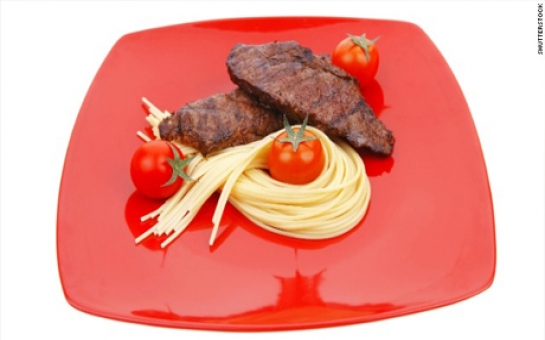Follow us !
Will seeing red help you lose weight?
Society
11:45 | 02.12.2013

Will seeing red help you lose weight?
As the holidays roll around, some of us can't wait to pile our plates with cookies, candy and family favorites.But if you're feeling overwhelmed by seasonal excess, try focusing on the color red. According to a new study, people tend to eat -- or use -- less of things presented on red dishes, whether it's chocolate or hand cream.BackgroundIf eating habits and color were on Facebook, their relationship status would be "it's complicated."Previously, scientists found diners at a pasta buffet heaped the marinara on if they used white plates, but took smaller helpings if their plates were red. They did the opposite when the pasta had a white sauce. So researchers thought the key to eating less might be sharp color contrasts.But the new study, published in the journal Appetite this month, indicates it's not contrast, but one specific color -- red -- that causes people to cut back on what they consume. The research tested how much food or hand cream people used when the product was placed on a red, white or blue plate."We wanted to find out if the effect was limited to eating or generalized to other types of consumption. The cream was a convenient way to evaluate another sensory system -- touch, rather than taste," said study author Nicola Bruno, cognitive psychology researcher at the University of Parma, Italy.The studyIn the new study, volunteers rated the saltiness of popcorn, nuttiness of chocolate and stickiness of hand cream.Each person received a pre-measured sample of a product on a plate that was one of three colors -- red, white or blue. The volunteers munched and moisturized as much as they liked while they filled out their answers. Of the 240 participants, 90 taste-tested popcorn, and 75 each sampled the chocolate chips and hand cream.Each survey also included a question to check how much testers liked the product, since this may have triggered them to eat or use more. After the experiments, researchers measured how much the testers had consumed.The authors also measured differences in the color intensity and contrasts of foods, cream and plates. Data in hand, they tested whether differences in people's consumption correlated with differences in color contrast.ResultsOn average, people ate less popcorn and chocolate when they were served on red plates compared to blue or white plates.Not surprisingly, self-reported popcorn fans ate more than those who expressed no preference for it on the survey. However, these people consumed more kernels independent of plate color. When researchers corrected for people's preferences in their statistical analysis, eating off red plates was still associated with lower consumption.Use of the moisturizing cream followed a similar trend. When testing hand cream on red plates, people used about half as much, on average, compared to cream on blue or white plates.Contrast had little to do with these results, said Bruno. Though dark chocolate on a red plate offered less contrast than pale colored popcorn or cream, people still took fewer chocolate chips."I expected to find the results related to differences in color intensity, but they did not. It's really related to the color red compared to the food and cream colors," he said.LimitationsThe study supports the idea that the color red reduces consumption, according to Oliver Genschow, who studies consumer psychology at the University of Mannheim.But don't run out and buy those red plates as a holiday gift just yet. In all the research so far, participants were unaware of the real reason for the tests, implying an unconscious process may be at work."We don't know what will happen if people are conscious of their plate's color. Maybe it won't work anymore," Genschow said.He says color may be an additional factor to consider when treating patients with certain eating disorders, but it's premature to suggest everyone trying to lose weight should simply switch to red plates.Next stepsPredicting our responses to color in the real world is difficult. In other contexts, researchers have found responses to red range from attraction to aversion. On safety gauges and signs, red is a near-universal warning of danger. But on lipstick, cocktail dresses, or roses, many see red as the most romantic color.Figuring out how colors influence our apparently spontaneous choices could eventually help design product packaging, restaurant interiors or consumer awareness programs. For now, this new study elucidates one aspect -- consumption."People believe all sorts of things about colors and motivation," Bruno said. "Some of these things may be true, but we need to do the science to be sure."(CNN)ANN.Az










